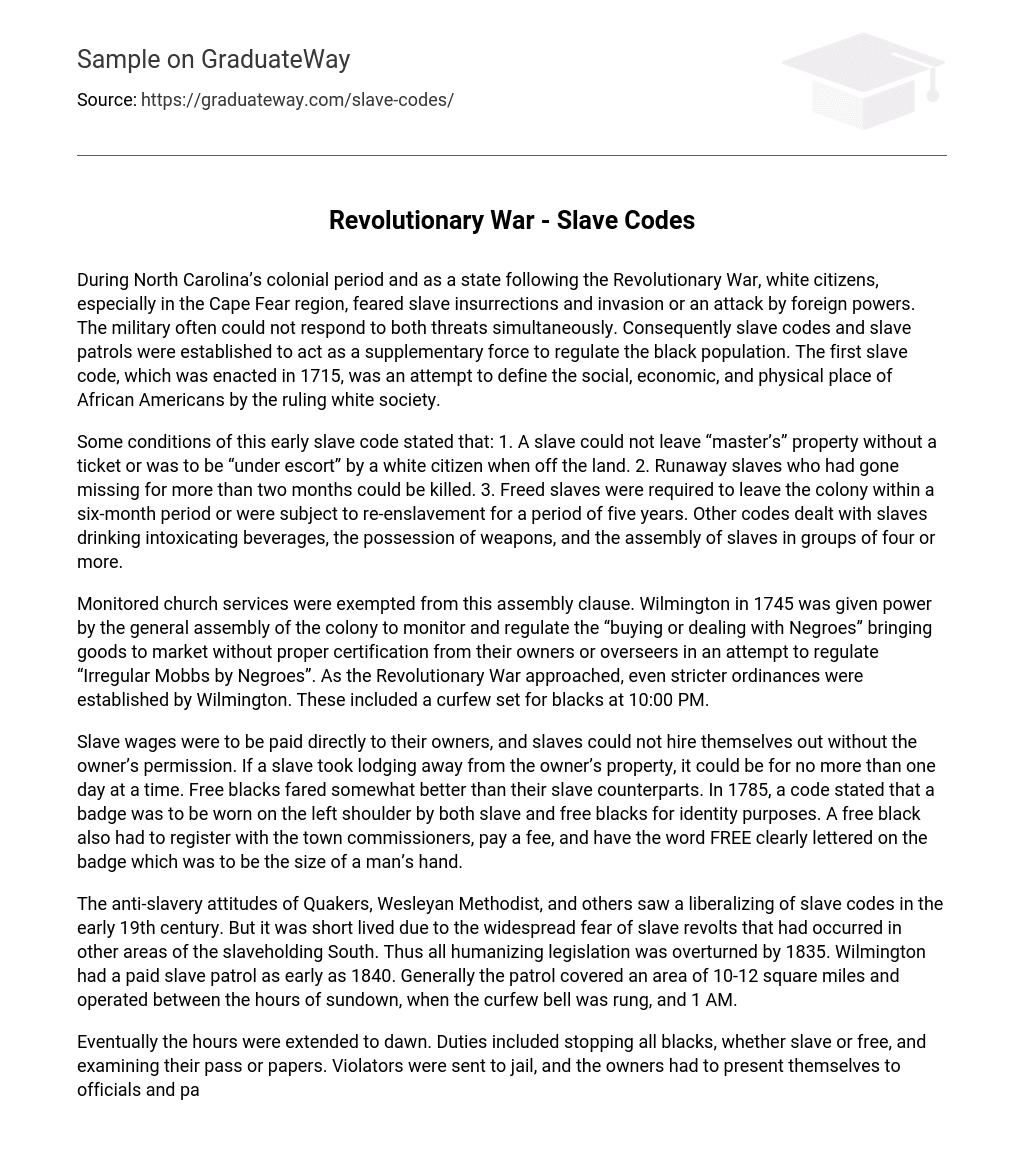During North Carolina’s colonial period and as a state following the Revolutionary War, white citizens, especially in the Cape Fear region, feared slave insurrections and invasion or an attack by foreign powers. The military often could not respond to both threats simultaneously. Consequently slave codes and slave patrols were established to act as a supplementary force to regulate the black population. The first slave code, which was enacted in 1715, was an attempt to define the social, economic, and physical place of African Americans by the ruling white society.
Some conditions of this early slave code stated that: 1. A slave could not leave “master’s” property without a ticket or was to be “under escort” by a white citizen when off the land. 2. Runaway slaves who had gone missing for more than two months could be killed. 3. Freed slaves were required to leave the colony within a six-month period or were subject to re-enslavement for a period of five years. Other codes dealt with slaves drinking intoxicating beverages, the possession of weapons, and the assembly of slaves in groups of four or more.
Monitored church services were exempted from this assembly clause. Wilmington in 1745 was given power by the general assembly of the colony to monitor and regulate the “buying or dealing with Negroes” bringing goods to market without proper certification from their owners or overseers in an attempt to regulate “Irregular Mobbs by Negroes”. As the Revolutionary War approached, even stricter ordinances were established by Wilmington. These included a curfew set for blacks at 10:00 PM.
Slave wages were to be paid directly to their owners, and slaves could not hire themselves out without the owner’s permission. If a slave took lodging away from the owner’s property, it could be for no more than one day at a time. Free blacks fared somewhat better than their slave counterparts. In 1785, a code stated that a badge was to be worn on the left shoulder by both slave and free blacks for identity purposes. A free black also had to register with the town commissioners, pay a fee, and have the word FREE clearly lettered on the badge which was to be the size of a man’s hand.
The anti-slavery attitudes of Quakers, Wesleyan Methodist, and others saw a liberalizing of slave codes in the early 19th century. But it was short lived due to the widespread fear of slave revolts that had occurred in other areas of the slaveholding South. Thus all humanizing legislation was overturned by 1835. Wilmington had a paid slave patrol as early as 1840. Generally the patrol covered an area of 10-12 square miles and operated between the hours of sundown, when the curfew bell was rung, and 1 AM.
Eventually the hours were extended to dawn. Duties included stopping all blacks, whether slave or free, and examining their pass or papers. Violators were sent to jail, and the owners had to present themselves to officials and pay a fine to get them back. Regular inspections of homes took place searching for weapons hidden by slaves. All white citizens were expected to participate in the slave patrols. It was a thorny issue especially among many non-slaveholding whites. Failure to serve on a patrol could result in substantial fines.
Over the years, slave patrol duties expanded so patrols also served as a town police force, arresting many drunken sailors, and as a fire watch. So successful were they at rounding up drunks that Wilmington had to build a larger jail in 1845. Generally speaking, slave patrols were less effective in action than they were on paper. It was virtually impossible to maintain surveillance over the entire black population both day and night. There were just too many places to hide and too many hours of darkness.
Daylight hours saw little checking of slaves for passes or papers in urban areas, and this was well known by the slave population. A runaway would therefore travel during the daytime and hide out during the cover of darkness hoping to receive help along the way from the Underground Railroad. The town of Greensboro was the center of the Underground Railroad for western and central North Carolina while Wilmington served the eastern portion of the state. Quaker ship owners, merchants and fishermen assisted as Railroad agents spiriting runaways to the north even as far as Canada.





